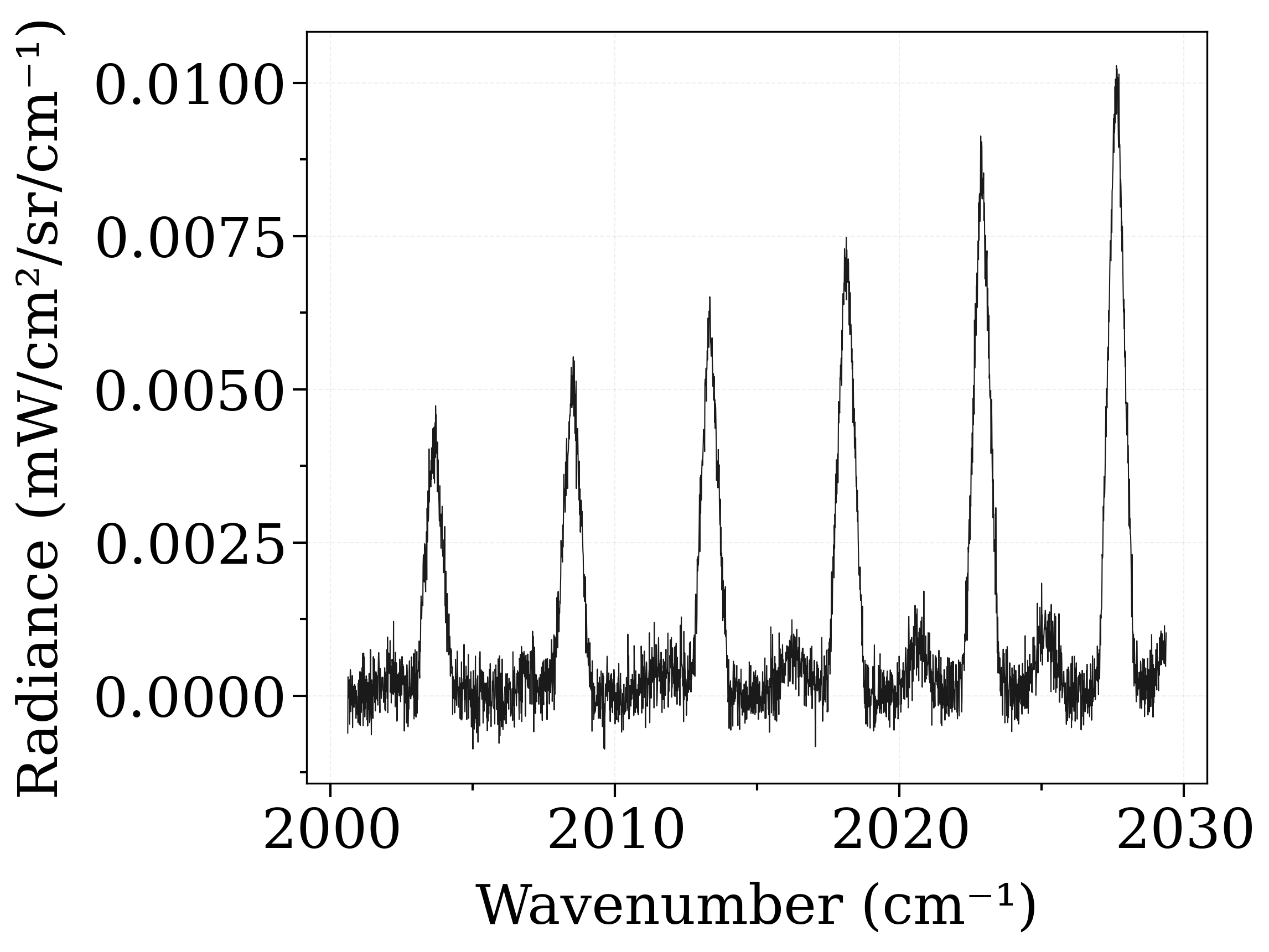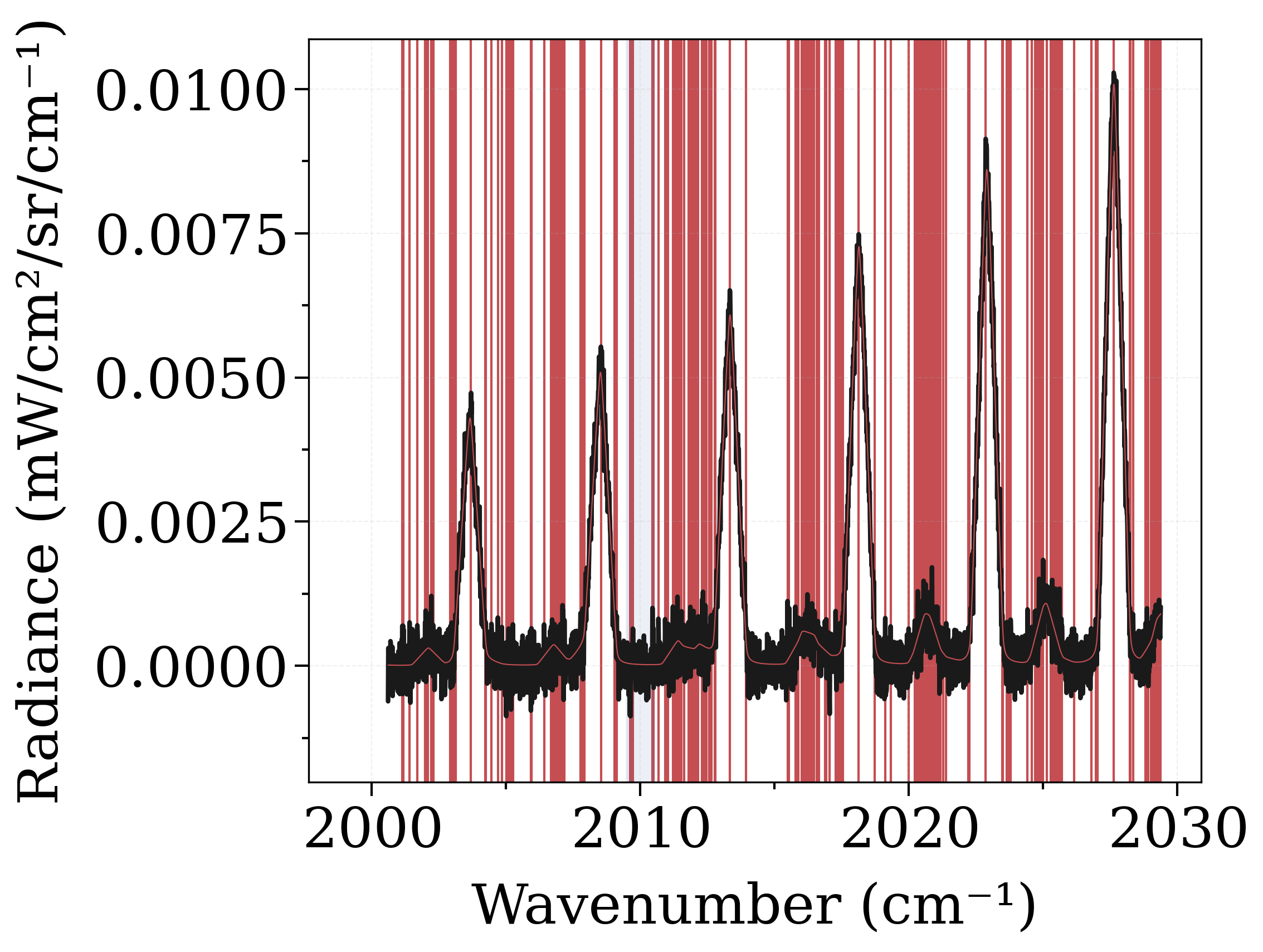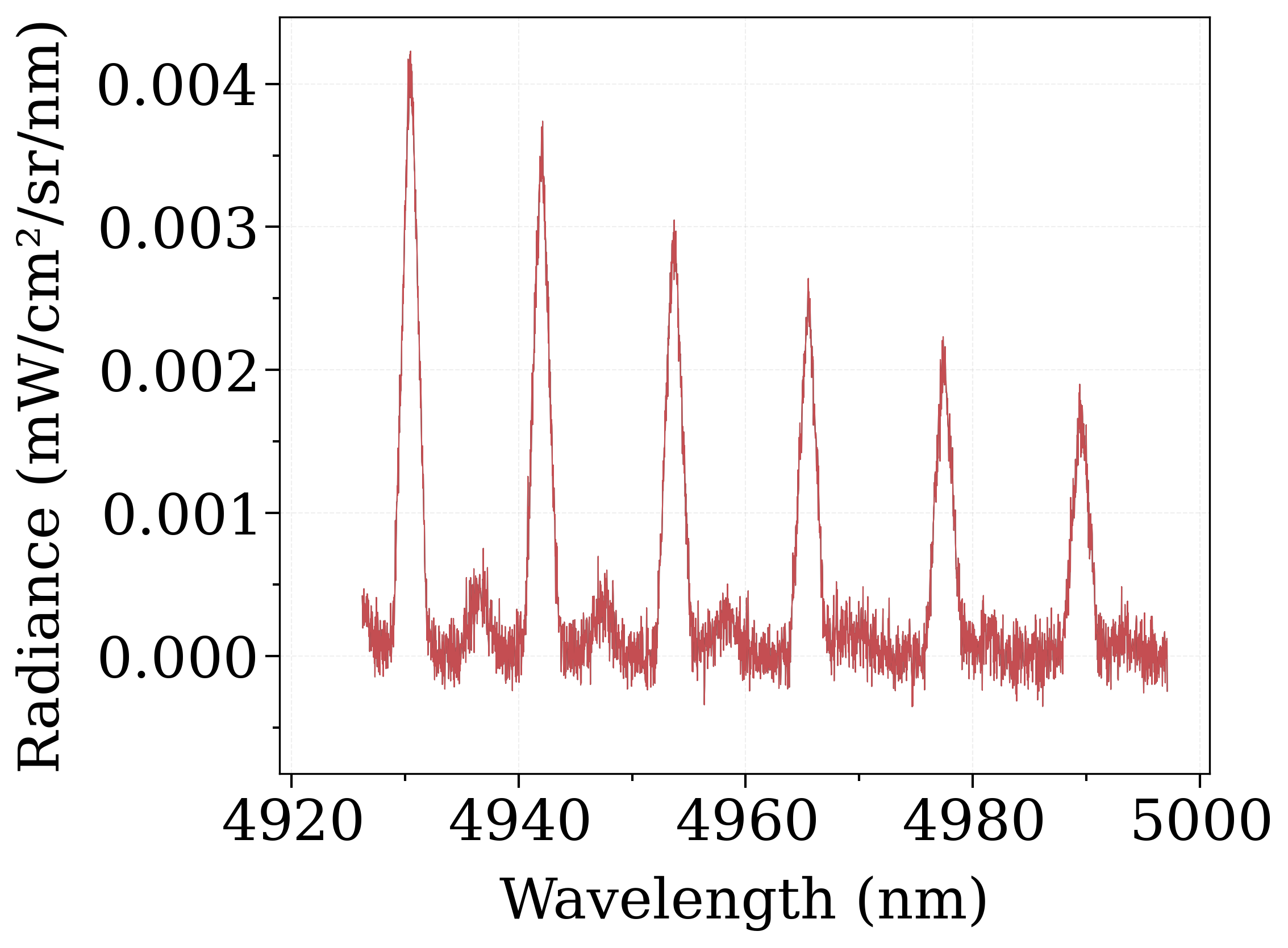Note
Run this example online :
Post-process using Specutils¶
Find peaks or uncertainties using the specutils library. A Radis Spectrum
object can easily be converted to a specutils specutils.spectra.spectrum1d.Spectrum1D
using to_specutils().
Below, we create a noisy spectrum based on a synthetic CO spectrum,
we convert it to specutils, add uncertainties by targeting a
noisy region, then determine the lines using find_lines_threshold() :
import astropy.units as u
import numpy as np
from radis import test_spectrum
""" We create a synthetic CO spectrum"""
s = (
test_spectrum(molecule="CO", wavenum_min=2000, wavenum_max=2030)
.apply_slit(1.5, "nm")
.take("radiance")
)
s.trim() # removes nans created by the slit convolution boundary effects
noise = np.random.normal(0.0, s.max().value * 0.03, len(s))
s_exp = s + noise
s_exp.plot()

Calculating Equilibrium Spectrum
Physical Conditions
----------------------------------------
Tgas 700 K
Trot 700 K
Tvib 700 K
isotope 1,2,3
mole_fraction 0.1
molecule CO
overpopulation None
path_length 1 cm
pressure_mbar 1013.25 mbar
rot_distribution boltzmann
self_absorption True
state X
vib_distribution boltzmann
wavenum_max 2030.0000 cm-1
wavenum_min 2000.0000 cm-1
Computation Parameters
----------------------------------------
Tref 296 K
add_at_used
broadening_method voigt
cutoff 1e-27 cm-1/(#.cm-2)
dbformat hitran
dbpath /home/docs/.radisdb/hitran/CO.hdf5
folding_thresh 1e-06
include_neighbouring_lines True
memory_mapping_engine auto
neighbour_lines 0 cm-1
optimization simple
parfuncfmt hapi
parsum_mode full summation
pseudo_continuum_threshold 0
sparse_ldm auto
truncation 50 cm-1
waveunit cm-1
wstep 0.01 cm-1
zero_padding -1
----------------------------------------
0.03s - Spectrum calculated
<matplotlib.lines.Line2D object at 0x7f848b9cbd30>
Determine the noise level by selecting a noisy region from the graph above :
spectrum = s_exp.to_specutils()
from specutils import SpectralRegion
from specutils.manipulation import noise_region_uncertainty
noise_region = SpectralRegion(2010.5 / u.cm, 2009.5 / u.cm)
spectrum = noise_region_uncertainty(spectrum, noise_region)
Find lines :
from specutils.fitting import find_lines_threshold
lines = find_lines_threshold(spectrum, noise_factor=2)
print(lines)
s_exp.plot(lw=2, show_ruler=True)
import matplotlib.pyplot as plt
for line in lines.to_pandas().line_center.values:
plt.axvline(line, color="r", zorder=-1)
s.plot(nfig="same")
plt.axvspan(noise_region.lower.value, noise_region.upper.value, color="b", alpha=0.1)

/home/docs/checkouts/readthedocs.org/user_builds/radis/envs/master/lib/python3.8/site-packages/specutils/analysis/flux.py:290: AstropyUserWarning:
Spectrum is not below the threshold signal-to-noise 0.01. This may indicate you have not continuum subtracted this spectrum (or that you have but it has high SNR features).
If you want to suppress this warning either type 'specutils.conf.do_continuum_function_check = False' or see http://docs.astropy.org/en/stable/config/#adding-new-configuration-items for other ways to configure the warning.
line_center line_type line_center_index
1 / cm
------------------ ---------- -----------------
2001.139999999999 emission 53
2001.169999999999 emission 56
2001.4099999999987 emission 80
2001.6999999999985 emission 109
2001.9899999999982 emission 138
2002.0099999999982 emission 140
2002.0399999999981 emission 143
2002.079999999998 emission 147
2002.099999999998 emission 149
2002.219999999998 emission 161
... ... ...
2029.2999999999734 emission 2869
2029.3299999999733 emission 2872
2029.3899999999733 emission 2878
2005.0099999999954 absorption 440
2005.1899999999953 absorption 458
2005.9299999999946 absorption 532
2005.9599999999946 absorption 535
2009.6199999999913 absorption 901
2009.6399999999912 absorption 903
2017.0599999999845 absorption 1645
Length = 194 rows
/home/docs/checkouts/readthedocs.org/user_builds/radis/envs/master/lib/python3.8/site-packages/radis/tools/plot_tools.py:599: UserWarning:
Couldn't add Ruler tool (still an experimental feature in RADIS : please report the error !)
<matplotlib.patches.Polygon object at 0x7f8467c16100>
Note: we can also create a RADIS spectrum object from Specutils
specutils.spectra.spectrum1d.Spectrum1D :
from radis import Spectrum
s2 = Spectrum.from_specutils(spectrum)
s2.plot(Iunit="mW/cm2/sr/nm", wunit="nm")
s_exp.plot(Iunit="mW/cm2/sr/nm", wunit="nm", nfig="same")
assert s_exp == s2

Total running time of the script: ( 0 minutes 3.881 seconds)



